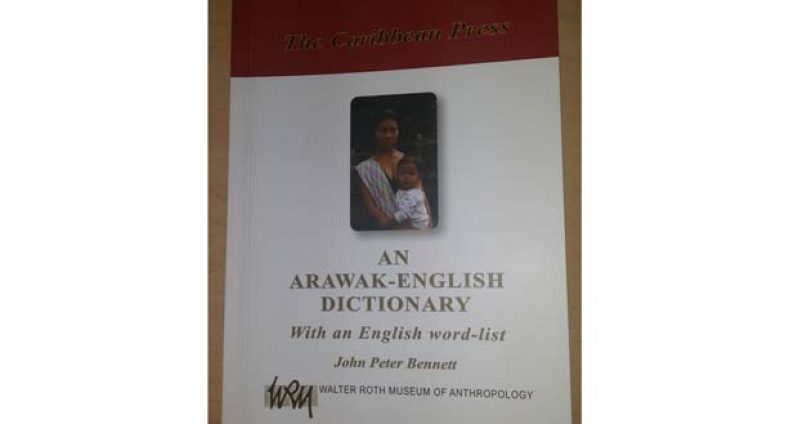With an English word-list
Introduction
Regularly between 1938 and 1945 I visited the Anglican Mission Stations of the Pomeroon parish once monthly with the Parish Priest. At one of these mission stations, Wakapoa, I used to listen to the children between eight and twelve years of age playing and singing during moonlit evenings. They sang in English but conversed in Arawak. I admired these children chattering in their own language.Some twenty years later, I visited the same place and head the children singing and talking. This time they sang creole songs and conversed in creolese. This helped to confirm an opinion I had been forming for some time: the people who spoke Arawak were getting fewer in number despite a natural increase in the Arawak population. Furthermore, I was at the time becoming particularly exasperated with the mispronunciation of Arawak words spoken by non-Amerindians. For instance, the furniture materials which the Arawaks call mibi and kofa have been corrupted to ‘neebee’ and ‘goofa’; the fish known to Arawaks as asa is now called ‘hassar’; the bird warakaba is called ‘warakabra’; and so on. But however excusable these utterings might have been by non-Arawaka, I was even more exasperated to hear Arawak children pronouncing the words in the same way. I remember voicing my concern to the Amerindian Captain of Kabakaburi at the time and there the matter rested.
Subsequently, the Jamaican writer Richard Hart, came to Guyana with camera and tape recorder to collect pictures, songs and legends of the Arawaks. The Amerindian Captain of Kabakaburi mentioned my concern. Richard Hart then obtained my address from the Archbishop of the West Indies and we subsequently corresponded for years. I was encouraged by him to record Arawak words and their meanings in English. I started that as a project and have found it a fascinating and enlightening pursuit.
I have examined the Revd. William Henry Brett’s Arawak nineteenth century translations of the four gospels and the Acts of the Apostles and marveled at their accuracy. I remember my father telling me that William Brett, an Englishman, spoke the Arawak language fluently and that his work of translation was done at Kabakaburi. The only criticism I have is on the omission of the letter ‘h’ in certain words, for example, Saci John instead of Sachi John; ororo instead of hororo; and a few other words. It is not a mistake, mind you, but it could be misleading. I have heard people say Makusi instead of Makushi. I have looked also at an Arawak word list compiled by Dennis Fanshawe, with Jonah Boyan, a native of Kabakaburi, giving the English meanings. Again I found a similar occurrence of the ‘h’ being left out. Of course, Fanshawe (1949) explained that he followed the Italian phonetic system.
A few words in this dictionary are pronounced differently by Arawak people of other districts of Guyana. For instance, there is an airstrip in the Moruka River which the Moruka Arawaks call Bemichi airstrip. If that airstrip were in the Kabakauri area, Arawaks would call it Bimiti airstrip. The Kabakaburi natives call Essequibo river Dishikibo whilst the Arawaks of other districts say Jishikibo. It is a minor difference, but it has been sufficient at times to provoke fierce controversy.
There are a few words beginning or ending with the syllable ‘ti’ or having it in the middle and I have found that most Arawak districts use the sound ‘chi’ instead. Some examples of these words are – timiti (troolie palm), timeta (to tie), timehi (a baby sling), tiba (a type of beetle). Itiki (the kiskadee bird), itika (faeces), mitiboko (a sea carrion crow). Timiti (troolie palm), hati (the wild rubber tree, fiti (a type of cricket—insect), koti (foot of an animal).
Interestingly, I found that Arawaks in Suriname use this ‘ti’ sound as well. Indeed, listening to a weekly broadcast in Arawak from radio Suriname, I found the pronunciation of Arawak words there not much different from that of the Kabakaburi area.
Since the geography of Guyana involves many Arawak names, I can see the usefulness of this Arawak dictionary in promoting the standard pronunciation of these names, in supplying their meanings and in offering explanations of their origins. Moreover, every word, phrase or even syllable used as a place name, or part of a place name, usually has a charming and sometimes humourous story behind it, for example, Ori noroko (Orinoco) snake mouth, Ituri Bishi (Ituribishi) baboon offspring, Malali (Demerara) rapids, Burishiri (Boerasiri) wasp.
As many Arawak words especially for the flora and fauna of Guyana have no English equivalents, I have used the scientific names in Fanshawe (1949).
(By John Bennett)













